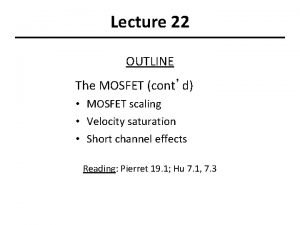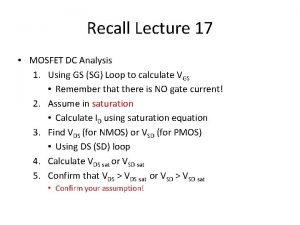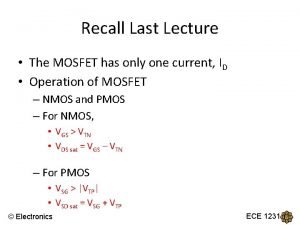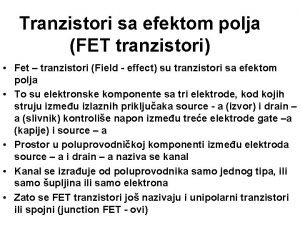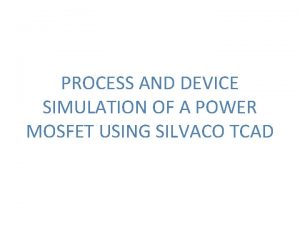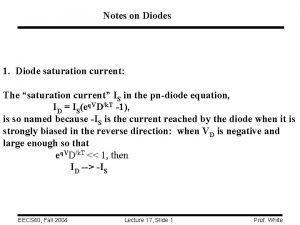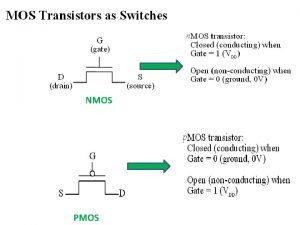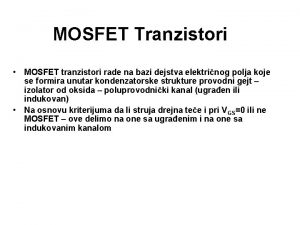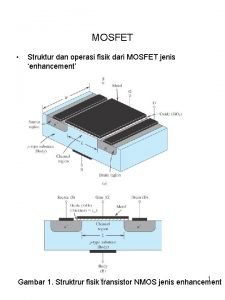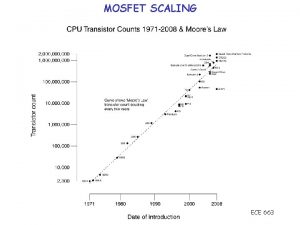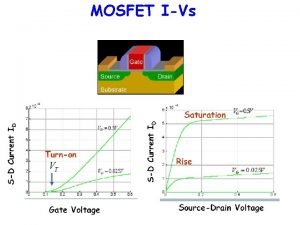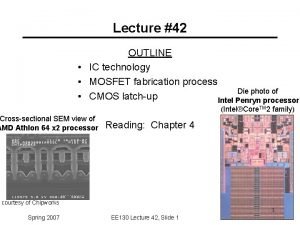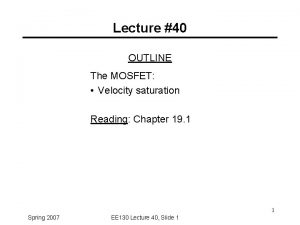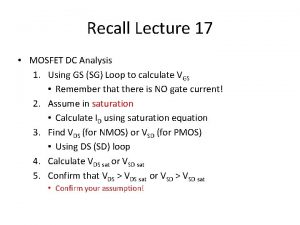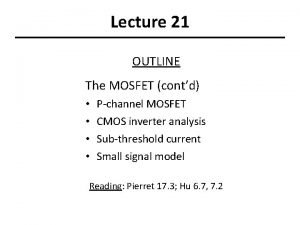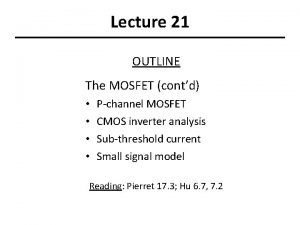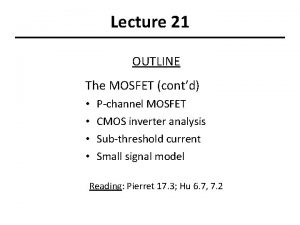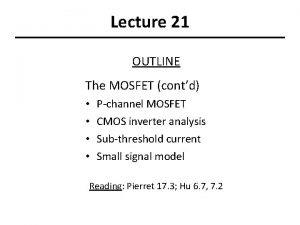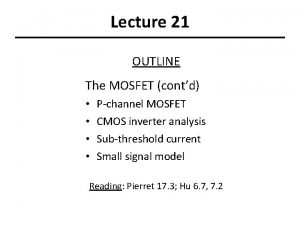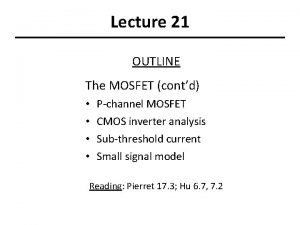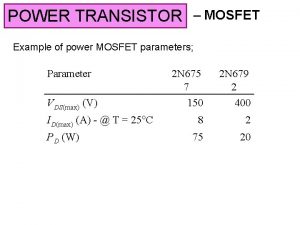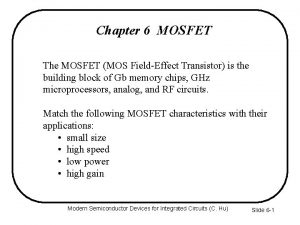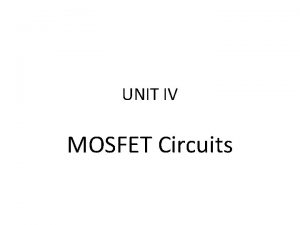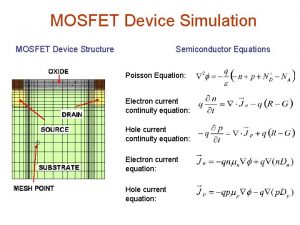Recall Lecture 17 MOSFET DC Analysis 1 Using


























- Slides: 26

Recall Lecture 17 • MOSFET DC Analysis 1. Using GS (SG) Loop to calculate VGS • Remember that there is NO gate current! 2. Assume in saturation • Calculate ID using saturation equation 3. Find VDS (for NMOS) or VSD (for PMOS) • Using DS (SD) loop 4. Calculate VDS sat or VSD sat 5. Confirm that VDS > VDS sat or VSD > VSD sat • Confirm your assumption!

APPLICATION OF MOSFETS

Digital Logic Gates NOR gate response NAND gate The NAND gate response 0 0 High 5 0 Low 5 0 High 0 5 Low 0 5 High 5 5 Low

CHAPTER 7 Basic FET Amplifiers

• For linear amplifier function, FET is normally biased in the saturation region.

AC PARAMETERS where

The MOSFET Amplifier - COMMON SOURCE • The output is measured at the drain terminal • The gain is negative value • Three types of common source – source grounded – with source resistor, RS – with bypass capacitor, CS

Common Source - Source Grounded ● A Basic Common-Source Configuration: Assume that the transistor is biased in the saturation region by resistors R 1 and R 2, and the signal frequency is sufficiently large for the coupling capacitor to act essentially as a short circuit.

EXAMPLE The transistor parameters are: VTN = 0. 8 V, Kn = 0. 2 m. A/V 2 and = 0. VDD = 5 V Rsi 520 k 0. 5 k ID = 0. 2441 m. A gm = 0. 442 m. A/V 320 k RD = 10 k

Steps 1. Calculate Rout 2. Calculate vo ____________________________ 3. Find vgs in terms of vi 4. Calculate the voltage gain, Av

0. 5 k RTH 198. 1 k 0. 442 vgs RD = 10 k 1. The output resistance, Rout = RD 2. The output voltage: vo = - gmvgs (Rout) = - gmvgs (10) = -4. 42 vgs 3. The gate-to-source voltage: , Ri = RTH vgs = [198. 1 / (198. 1 + 0. 5 )] = 0. 9975 vi = 1. 0025 vgs 4. So the small-signal voltage gain: Av = vo / vi = - 4. 42 vgs / 1. 0025 vgs - 4. 41

Type 2: With Source Resistor, RS VTN = 1 V, Kn = 1. 0 m. A / V

Perform DC analysis Assume transistor in saturation VG = ( 200 / 300 ) x 3 = 2 V Hence, KVL at GS Loop: VGS + IDRS – VTH = 0 VGS = 2 – 3 ID KVL at DS loop VDS + 10 ID + 3 ID – 3 = 0 VDS = 3 -13 ID Assume biased in saturation mode: Hence, ID = 1. 0 (2 – 3 ID - 1 )2 = 1. 0 (1 – 3 ID )2 9 ID 2 – 7 ID + 1 = 0 VTN = 1 V, Kn = 1. 0 m. A / V

ID = 0. 589 m. A VGS = 2 – 3 ID = 0. 233 < VTN MOSFET is OFF Not OK ID = 0. 19 m. A VGS = 2 – 3 ID = 1. 43 V > VTN OK VDS = 3 -13 ID = 0. 53 V VDS sat = VGS - VTN = 1. 43 – 1. 0 = 0. 43 V 0. 53 V > 0. 43 V Transistor in saturation Assumption is correct!

Steps 1. Calculate Rout 2. Calculate vo ____________________________ 3. Find v’ in terms of vgs 4. Find v’ in terms of vi 5. Calculate the voltage gain, Av

+ V’ RTH 66. 67 k - RD = 10 k RS = 3 k gm = 0. 872 m. A/V 1. The output resistance, Ro = RD 2. The output voltage: vo = - gmvgs. RD = - 0. 872 ( vgs) (10) = - 8. 72 vgs 3. Find v’ v’ = vgs + gmvgs RS v’ = vgs(1 + 2. 616) = 3. 616 vgs

+ V’ - RTH 66. 67 k RD = 10 k RS = 3 k 4. Find v’ in terms of vi : using voltage divider v’ = [RTH / (Rsi + RTH)] vi But in this circuit, Rsi = 0 so, v’ = vi = 3. 616 vgs 5. Calculate the voltage gain AV= vo / vi = - 8. 72 vgs / 3. 616 vgs = - 2. 41

Type 3: With Source Bypass Capacitor, CS Ø Circuit with Source Bypass Capacitor ● An source bypass capacitor can be used to effectively create a short circuit path during ac analysis hence avoiding the effect RS ● CS becomes a short circuit path – bypass RS; hence similar to Type 1

Steps 1. Calculate Rout 2. Calculate vo ____________________________ 3. Find vgs in terms of vi 4. Calculate the voltage gain, Av

IQ = 0. 5 m. A hence, ID = 0. 5 m. A gm = 2 Kn ID = 1. 414 m. A/V ro = RG 200 k 1. 414 vgs RD = 7 k

1. The output resistance, Rout = RD 2. The output voltage: vo = - gmvgs (RD) = -1. 414 (7) vgs = - 9. 898 vgs 3. The gate-to-source voltage: vgs = vi in parallel ( no need voltage divider) 4. So the small-signal voltage gain: Av = -9. 898 vgs / vgs = - 9. 898

The MOSFET Amplifier - COMMON DRAIN • The output is measured at the source terminal • The gain is positive value

0. 5 k 150 k 113. 71 RTH k 470 k 0. 75 k ID = 8 m. A , Kn = 4 m. A /V 2 gm = 2 Kn ID = 11. 3 m. A/V

Steps 1. Calculate Rout 2. Calculate vo ____________________________ 3. Find v’ in terms of vgs 4. Find v’ in terms of vi 5. Calculate the voltage gain, Av

gm = 2 Kn ID = 11. 3 m. A/V + v’ - 1. The output resistance: Ro = ro || Rs 2. The output voltage vo = gmvgs (ro RS) = 11. 3 vgs (0. 70755) = 8 vgs 3. v’ in terms of vgs using supermesh: vgs + gmvgs (ro RS) – v’ = 0 v’ = vgs + 8 vgs = 9 vgs 4. v’ in terms of vi: v’ = (RTH / RTH + RSi) vi = 0. 9956 vi 9 vgs = 0. 9956 vi = 9. 040 vgs 5. The voltage gain A = v / v = 8 v / 9. 040 v = 0. 885 v o i gs gs

Output Resistance for Common Drain Ix + - • ro|| Rs = 0. 708 k Vx • vgs in terms of Vx where vgs = -Vx • - Vx + gmvgs + Ix = 0 0. 708 • - Vx - gm. Vx + Ix = 0 0. 708 - 1. 412 Vx – 11. 3 Vx + Ix = 0 Ix = 12. 712 Vx 0. 079 k
 Mosfet
Mosfet 01:640:244 lecture notes - lecture 15: plat, idah, farad
01:640:244 lecture notes - lecture 15: plat, idah, farad Mosfet pi model
Mosfet pi model Dc analysis of mosfet
Dc analysis of mosfet Drain current formula in mosfet
Drain current formula in mosfet Exploratory data analysis lecture notes
Exploratory data analysis lecture notes Sensitivity analysis lecture notes
Sensitivity analysis lecture notes Factor analysis lecture notes
Factor analysis lecture notes Analysis of algorithms lecture notes
Analysis of algorithms lecture notes Streak plate method performed on
Streak plate method performed on Power system analysis lecture notes
Power system analysis lecture notes Using system.collections.generic
Using system.collections.generic Dtfd switch
Dtfd switch Fet tranzistor
Fet tranzistor Mosfet de depleção
Mosfet de depleção Application of power mosfet
Application of power mosfet Saturation current diode
Saturation current diode Kmap
Kmap Mosfet sa ugradjenim kanalom
Mosfet sa ugradjenim kanalom Mosfet basic operation
Mosfet basic operation Mosfet scaling
Mosfet scaling Gm formula for mosfet
Gm formula for mosfet Fet iv curve
Fet iv curve Dual gate mosfet rf amplifier
Dual gate mosfet rf amplifier Mosfet noise model
Mosfet noise model Pmos fabrication process steps
Pmos fabrication process steps Velocity saturation mosfet
Velocity saturation mosfet
